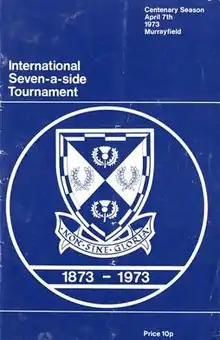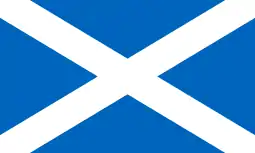1973 International Seven-a-side Tournament
The 1973 International Seven-a-side tournament was the first rugby sevens tournament to feature national representative teams,[1] predating the first official Rugby World Cup Sevens by twenty years. Held in Scotland as part of the Scottish Rugby Union's centenary celebrations, the tournament featured players from all eight of the members of the IRB. Although not sanctioned by the IRB as an official world cup the winners, England, were hailed by the press as the world seven-a-side champions.[2]
 | |
| Tournament details | |
|---|---|
| Host nation | |
| Dates | 7 April 1973 – 7 April 1973 |
| No. of nations | 7 (plus a SRU President's VII) |
| Champions | |
| Tournament statistics | |
| Matches played | 13 |
Background
1973 was the centenary year of the Scottish Rugby Union ("SRU") and as part of the centenary celebrations the SRU decided to hold an international Rugby sevens tournament. The president of the SRU at the time, A.W. Wilson, later wrote of the decision to hold a sevens tournament, "It seemed most appropriate to us, in our Centenary Year, that we should pay some regard to a part of the game which has proved exhilarating and entertaining to us. One might say, a part of the heritage of Scotland and, of course, especially the Borders. An international Seven-a-side Tournament was the answer. All the countries taking part were and are thrilled at this prospect."
The tournament was not advertised as a world cup but rather was styled "The International Seven-a-side tournament". It was held on 7 April 1973 in Edinburgh, and all the International Rugby Football Board countries were represented, with the exception of South Africa. There was, however, South African representation in the form of several players in the eighth side in the tournament, the President's VII.
As in 1883 when the Scots invented Rugby Sevens, the tournament was to lead a trend. However, even though sevens had been established for 90 years, even the event program recognised its contemporary status by the inclusion in the inside front cover of an advertisement for Peter Scott Knitwear, featuring a man and woman in sweaters, looking amazed and accompanied by the caption: "International Seven-a-sides. What next?". The programme for the event also sported the new coat of arms of the SRU that was granted by the Lord Lyon King of Arms on 28 February 1973, for the centenary season. The coat of arms is still in use today, but in the main the SRU use the commercial thistle logo on jerseys and stationary. The coat of arms has the motto "Non Sine Gloria", meaning "Not Without Glory".
Participating nations
The eight teams were divided into two pools of four as follows with each team playing each other within their pool once. The winners of each Pool went through to contest the final:
| Pool A | Pool B |
|---|---|
|
Results
Pool A
Team Pld W L PF PA +/- Pts  Ireland
Ireland3 3 0 62 34 28 6  New Zealand
New Zealand3 2 1 58 50 8 4  Scotland
Scotland3 1 2 42 60 -18 2 .svg.png.webp) Australia
Australia3 0 3 28 46 -18 0
Squads
The eight teams were divided into two pools of four as follows: Source: The primary source for the squads below is the Official programme for the tournament. Wherever it is known that the players who played on the day differ from the programme details, this takes precedence, and is noted.
Pool A
|
|
|
|
Notes to Pool A
- JJ Moloney of St Mary's College, was named in the programme for Ireland instead of D.M. Canniffe, but was unable to play.[3]
- GK Oliver of Gala was named in the programme for Scotland but his teammate, Arthur Brown, is known to have played instead.[4]
Pool B
|
President's VII
|
|
Summary
The teams put forward by the various nations featured many names with test-status fifteen-aside careers. The Scottish side had a number of sevens specialists, many from the Gala club that itself had for a number of years previous had an excellent run of form. The three Browns, all unrelated, Frame and Gill all from the Gala club joined a former Galalean in Stan Davidson and Colin Telfer, as the main Scottish side. Another Gala player, Nairn MacEwan, was on the bench for the President's VII.[4] In the group stages, the tournament had a huge upset when a star-studded Welsh team including Gareth Edwards, Gerald Davies, Phil Bennett, and JPR Williams were beaten by an England side that included a number of Loughborough Colleges students.[1]
The groups were dominated by Ireland and England who both emerged with a perfect 3 wins out of 3. The final was an extremely close affair and Ireland missed out on the title by the smallest of rugby margins. In injury time, Ireland were leading 18-16 and were in the England 22. Fergus Slattery needed only to hold on to the ball to preserve this lead but instead let loose an errant pass, which was intercepted and the England full international winger, Keith Fielding, was able to run in the long try.[5] The England side was a strong one, with all players to be full internationals. Loughborough Colleges' Fran Cotton was the captain and in the final both Keith Fielding and Andy Ripley scored. Mike Gibson, of Ireland, was selected the tournament's outstanding player.[5]
Status of tournament
The tournament was held twenty years before the first official world cup, yet in a number of quarters was referred to as a world championship. The SRU itself did not advertise it as a world cup but rather it was styled "The International Seven-a-side tournament". Additionally, it was not officially endorsed by the International Rugby Football Board as anything other than an international tournament. However, elements of the press referred to it variously as bestowing the World Sevens Crown[6] or conferring the status of world sevens' champions[5] or World Seven-a-side Champions,[7] and even modern press reports, in the era of the fully sanctioned World Cup, have referred to the competition in comparable terms to modern World Cups.[8]
See also
References
- The Sevens wonder of the world, (IRB.COM) Friday 14 August 2009, by Chris Thau
- The Straits Times, 9 April 1973
- Official Ireland Rugby website SEVENS (IRELAND SQUADS AND RESULTS IN SEVENS TOURNAMENTS)
- David Ferguson: Gala ready to celebrate its magnificent sevens, Published Date: 2 May 2009
- In its "History of Sevens" Rugby7.com refer to Ireland missing being the first world sevens' champions by a hair. Archived 13 January 2011 at the Wayback Machine
- "England clinch world 'sevens' crown". The Straits Times. 9 April 1973.
- Barry Bowker, England Rugby - A History of the National Side, 1871-1978, p178, 1976 (Cassel Ltd)
- The Telegraph, Rugby Sevens World Cup could lead to Olympic glory by Brendan Gallagher, published: 9:55PM GMT 3 Mar 2009